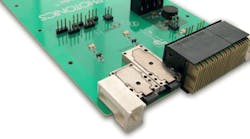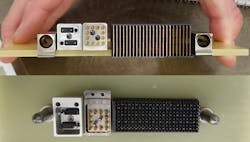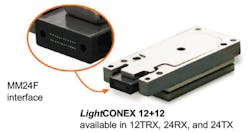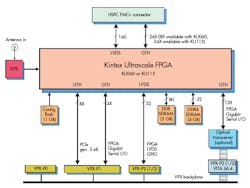VITA’s VPX rugged board standards continue to push the performance envelope. Connectors like TE Connectivity’s MULTIGIG RT 2 meet VITA 66 standard requirements. It’s able to handle 10-Gb/s signals including Ethernet, InfiniBand, and Serial RapidIO. The wafer-based plugs can be optimized for high-speed, serial differential signals. Still, there are applications that require coax or optical connections. This is where VITA 66 optical and VITA 67 coax RF connections come into play (Fig. 1).
1. This 3U VPX interface employs MULTIGIG RT 2, VITA 66 optical, and VITA 67 coax RF connectors.
Optical and coax connectors can be placed in the P2 slot on cards and the backplane, allowing rugged boards to connect to this interface simply by sliding the board in. Blind mating can be a challenge, but these two standards support this operation using floating ferrules for RF connections and additional alignment posts. As a result, boards can be swapped hundreds of times, if necessary.
Though the standards and support hardware started with a few connections, they have increased performance and the number of connections. The latest Reflex Photonics’ LightCONEX module supports up to 24 lanes (Fig. 2). The LightABLE optical transceivers can use OM3 cable connections up to 300 m running at speeds up to 12.5 Gb/lane with a bit error rate of 10-15. The modules include equalizers and pre-emphasis support to compensate trace impedance. The connections are compatible with OM3 and OM4 optical ribbon cables. The modules support the current VITA 66.4 and forthcoming VITA 66.5 standards.
2. Reflex Photonics’s 24-lane LightCONEX module supports blind mating.
In addition, Reflex Photonics has a line of radiation-hardened LightSPACE optical transceivers. They’re tested per the ECSS-Q-ST-60-15C standard, including proton testing for Total Non-Ionizing Dose (TNID), heavy ion testing for Single Event Effect and Latch-up (SEE and SEL) and Gamma Ray using Cobalt-60 for Total Ionizing Dose (TID). The modules can handle doses over 100 krad.
The system also uses spring-loaded MT ferrules. The low-profile, 10-mm height can be handy in application areas other than VPX. The 12-lane LightCONEX module uses only 1.4 W while the 24-lane version needs only 2.8 W.
Optical and RF connections are common on high-speed FPGA boards like Pentek’s latest Model 5983 FMC carrier board with an on-board Xilinx Kintex UltraScale FPGA. The optional VITA 66.4 optical interface is driven by a dozen FPGA, high-speed SERDES (Fig. 3).
3. Pentek’s Model 5983 FMC carrier board can use a VITA 66.4 optical interface with the on-board Xilinx Kintex UltraScale FPGA.
The VPX platform is invaluable for military and avionics applications that have high shock and vibration requirements. RF and optical cabling provides performance and distance advantages over the conventional copper backplane support.





